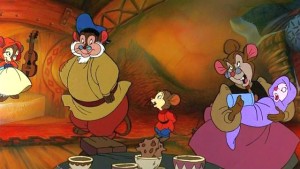I remember being a little kid, and the excitement of the Christmas Season, circa 1986, was engulfing me when I accompanied my mother and older brother to the mall theatre to see the newly released and critically acclaimed animated movie “An American Tail.”
Thirty years have passed since that time, and I can say with complete honesty I haven’t watched one second of the movie since. Animated April brought “An American Tail” back to my conscious – this time a sharp tongued critic would be replacing the wide-eyed awe of a child.
My first thought seconds in was an astonishment of how dated the animation was. 1986 was a long time ago certainly, but the simple colors and basic sketches seemed relics in an era just before the animation boom of the 90s. It doesn’t suffer from it by any means, it’s just plainly obvious that it lacks the punch of today’s creators. You could be told the movie came out in 1946 and would be hard pressed not to accept that when watching.
“An American Tail” would be legendary filmmaker Stephen Spielberg’s first venture into animation, and the effort would yield success at the box office, with the movie being the highest grossing non-Disney film at the time.

Occurring in 1885, the Mousekewitz family patriarch, simply referred to as Papa, tells the lore of American greatness with the fervor of a modern day destitute. A parallel is drawn between cats and communists, and a handful of catchy songs are dispersed throughout.
The main song along the journey will surely get stuck in your head as Papa Mousekewitz leads the fun though erroneous notion that “there are no cats in America, and the streets are paved with cheese.”
Through animation, “An American Tail” manages to capture the plight of the mice, who could be substituted for any real life immigrants, and the social struggles that accompany leaving a barren and desolate land of limited prospects for the chance at a better life thousands of miles way.
A seedy rodent called Warren T. Rat represents the antagonist of the story as he quickly pulls dubious cards on Fivel, and a gentle vegetarian cat (voiced perfectly by comic legend Dom DeLuise) serves to eliminate Fivel’s prior misgivings about the species.
“An American Tail” was nominated for one Academy Award of Best Song with “Somewhere Out There” a tune made famous by Linda Ronstadt and James Ingrim that fits the movie like a smooth leather glove.
While released at Christmas time, the movie isn’t exactly a holiday based one, though the opening Hanukkah sequence and colorful animation make it an acceptable addition to your December movie rotation.
It’s a bit kiddish, but the simple animation works. The lack of CGI and other present day tricks leave you in awe of a perfect animated movie in a time that’s sadly long gone. “An American Tail” is an enjoyable watch, and a glimpse into a forgotten era of great animated movies.
by – Matt Christopher